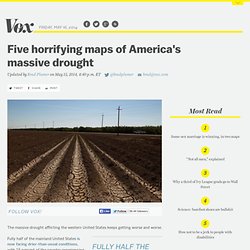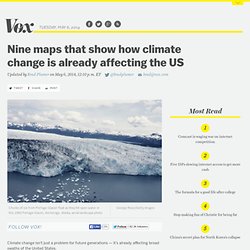

Ice still present on Lake Superior in July! Five horrifying maps of America's massive drought. The massive drought afflicting the western United States keeps getting worse and worse.

Fully half the mainland United States is facing drought Fully half of the mainland United States is now facing drier-than-usual conditions, with 15 percent of the country experiencing "extreme" to "exceptional" drought. What's more, California is facing one of its worst dry spells on record — with every single part of the state now in drought. Polar vortex may mean miserable allergy season. Now that hay fever season has hit, your first instinct might be to pop an antihistamine.

It's not a bad one: "If you have allergies, one of the best things you can do is start medications early, even before your symptoms kick in," says Dr. Neeta Ogden, an allergist in New York.But, she adds, it's also crucial to make tweaks to your daily routine to avoid whatever sparks your symptoms. Read on for easy, effective ways to keep sniffles at bay 24/7.
Tree and grass pollen -- the main causes of spring allergies -- can blow into your house if you open your windows even a crack, "especially during the early morning hours, when tree pollen counts are typically the highest," says Dr. Vincent Tubiolo, an allergy, asthma and immunology specialist in Santa Barbara, California.Stuffy inside? Visit weather sites, watch your local morning news or download the Pollen.com app for your phone. Research shows that stress can aggravate allergic reactions, even a full day after an anxiety-producing event. Nine maps that show how climate change is already affecting the US. Climate change isn't just a problem for future generations — it's already affecting broad swaths of the United States.

That's the upshot of the National Climate Assessment, a massive new US government report detailing the current and future impacts of global warming around the country. The report is particularly useful in detailing how specific regions and sectors will be affected — and outlining some possible ways we could adapt. Etats-Unis : 18 morts dans le glissement de terrain.
Fukushima fallout being spread by typhoons - World. Typhoons that hit Japan each year are helping spread radioactive material from the Fukushima nuclear disaster into the country's waterways, researchers say.

A joint study by France's Climate and Environmental Science laboratory (LSCE) and Tsukuba University in Japan found contaminated soil is being washed away by the high winds and rain and deposited in streams and rivers. A tsunami sparked by an earthquake slammed into the Fukushima plant in March 2011, sending reactors into meltdown and causing the worst atomic accident in a generation. A large number of radioactive particles were spewed into the atmosphere, dispersing cesium particles which cling to soils and sediment. Studies have shown that soil erosion moves the radioactive varieties of cesium-134 and 137 from the northern mountains near Fukushima into rivers, and then out into the Pacific Ocean.
"There is a definite dispersal towards the ocean," LSCE researcher Olivier Evrard said. Rare California tornadoes caught on tape - CNN.com Video. 8 Foods That California’s Drought Will Make More Costly. Most people expected food prices to rise over time as California’s drought worsened earlier this year, but some goods will be impacted more than others.

Research from Timothy Richards, a professor of the W. P. Carey School of Business at Arizona State University, shows that vegetables like lettuce and avocados are likely to experience the most dramatic prices bumps. “We can expect to see the biggest percentage jumps in prices for avocados and lettuce—28 percent and 34 percent, respectively,” Richards said. “People are the least price-sensitive when it comes to those items, and they’re more willing to pay what it takes to get them.” Time will tell if people feel the same way about the other items on Richards’ research list. Richards says industry estimates range from a half-million to 1 million acres of agricultural land likely to be affected by the drought.
Why It's a Big Deal That Half of the Great Lakes Are Still Covered in Ice. This story originally appeared in The Atlantic Cities and is republished here as part of the Climate Desk collaboration.

Over the winter, as polar vortices plunged the US Midwest into weeks of unceasing cold, the icy covers of the Great Lakes started to make headlines. With almost 96 percent of Lake Superior's 32,000 miles encased in ice at the season's peak, tens of thousands of tourists flocked to the ice caves along the Wisconsin shoreline, suddenly accessible after four years of relatively warmer wintery conditions. The thing is, all of that ice takes a long time to melt. As of April 10, 48 percent of the five lakes' 90,000-plus square miles were still covered in ice, down from a high of 92.2 percent on March 6 (note that constituted the highest levels recorded since 1979, when ice covered 94.7 percent of the lakes).
Last year, only 38.4 percent of the lakes froze over, while in 2012 just 12.9 percent did–part of a four-year stint of below-average iciness.